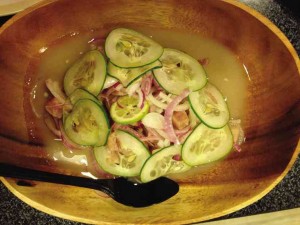
After whining last week about food at beach resorts these days not being beachy enough, my online research for where to go on Saturday night threw up an interesting possibility: a restaurant that specializes in two things that, for me, would go perfectly with sand between one’s toes and a clear, motionless blue horizon.
Patricio’s isn’t by the beach; in fact, it isn’t really by anything at all. In theory it’s part of Taguig, but not the hopping, grinding, slinky party strip of Bonifacio Global City. From where the Fort meets McKinley road, it’s about a five-minute drive through the darkened, tree-lined lanes of the old army base.
Among the understated establishments on Bayani Street is a cevicheria, which I wasn’t sure wasn’t a made-up word. But apparently it exists and is, as you might suspect, a place where one goes to eat ceviche, the Peruvian counterpart of kinilaw. Upon entering we were greeted by the owner, which sounds like a cliché, but I rarely get to use it these days because at most restaurants, the owner or manager, is nowhere in sight.
My wife and I shared one of the recommended kinilaw dishes, the pork, and two of the five “shooters,” which are smaller and more intensely flavored kinilaw dishes.
One cannot mention kinilaw without at least a token reference to the late Doreen Fernandez’s work on the subject, and quotes from her book, are reprinted on the walls of this restaurant. For her it was the most Filipino of Filipino dishes—pre-colonial, primordial and an emanation of something buried deep within our spirit.
I say “buried” because it’s hard to get a good kilawin these days, even if you go out of town. Most restaurant kilawin is fish that has been sitting in acetic acid so long that it has toughened into tough, chewy little pieces, the texture and color of a schoolboy’s eraser. Out of town it’s often just as bad, plus dysentery.
Gastronomic delight
There are rumors, whispered among foodies, of a kinilaw master, a recluse who lives in anonymity in the Visayas, like a kung fu master who has to be drawn out for one last fight. First you have to find him, and then take him aboard your yacht. Then from some gnomic memory he will, depending on the catch of the day, produce masterpiece after masterpiece of gastronomic delight for the lucky diners, working purely from instinct, before disappearing into sea-mist.
The story has passed into legend, along with good kinilaw, which I’ve always thought a pity because if Japan has sushi masters, why can’t we have kinilaw masters? The idea is the same: work with the freshest fish, work quickly, work with the seasons and work for oneself rather than to please a crowd.
Kinilaw, like sushi, can’t be mass-produced, and has to be eaten almost immediately after it’s made.
The eponymous Patrick and his wife Pia aren’t kinilaw masters yet, but they’re well on their way; they have the dedication and desire to experiment, and right now it’s a deserted playing field.
The Kinilaw de Oro, which we shared, is one of the best examples of the genre I’ve had in recent history. It had been made recently (we later learned that they are made to order), and used good vinegar, not industrial acid in a bottle. The seasoning was not something that I was familiar with; and when we later asked them about it, they produced several extremely strange-looking fruits and, I believe, a tuber.
I promptly forgot what they were called, but all of them, including the lime used to brighten further the seasoning, are flown in from Mindanao (the husband is a pilot).
More intense
I thought that with the smaller-scale dishes the flavors were more intense and more coherent: the tuna with sesame is an old trick and wasn’t drowned in oil as it sometimes is; the shrimp kinilaw (one with mango and wasabi, the other with chillies) were both stellar, the shrimp barely cooked and with a firm bite and crunch.
But I wondered if part of the problem with the larger dishes is that kinilaw is not meant to be eaten by a solitary diner, like a Michelin inspector, but shared among a large table of friends. And I could well imagine, and do suggest, going as a large group and getting several of the platters and sharing them, so that you get only a few bites before your palate gets refreshed by a new set of flavors.
The lechon kawali is competent, though you wouldn’t go there just for that. But one does need it to get something warm and meaty in the tummy and for the fat to marry with the vinegar.
With an iced Cerveza Negra, it’s a unexpected taste of the ocean in the middle of the city. And with more experimentation and new dishes on the way, the future is promising, while the present is highly recommended.
Patricio’s is at 28 Bayani Road, Bonifacio Global City, Taguig. Call 9987274.

